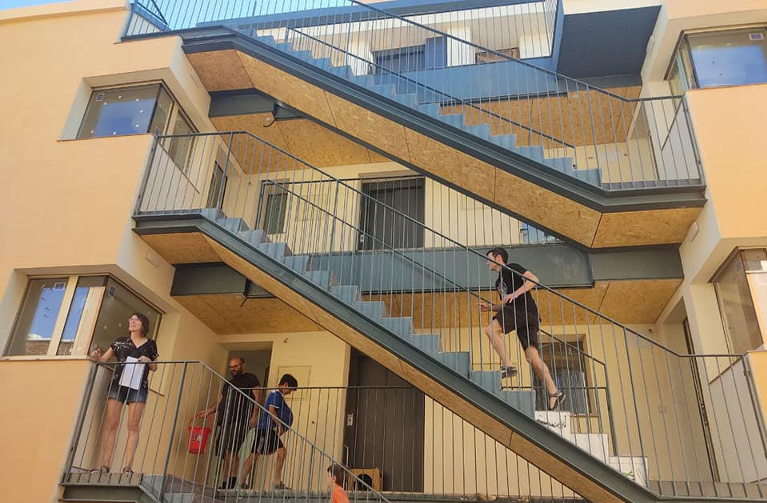When Nacho Garcia was 23 years old, he had an idea. What if he could establish a communally-owned housing operation in his own neighborhood? It would take over 20 years, but in October 2020, Garcia’s dream became a reality. Entrepatios, a cohousing building in Madrid, is now home to 17 families and boasts the title of the first zero carbon footprint housing cooperative in the city.
Humble beginnings
“The origin of everything was Covijo, which was a young housing cooperative project,” explains Garcia. It was 2002 when about fifty young people from Madrid formed a cooperative and asked the City Council to give them land to build a cooperatively-managed housing building.
“It was the embryo of the cooperative housing model in Spain, and it was closely linked to the right-to-housing movement. We all came from groups like V de Vivienda, a predecessor of the Plataforma de Afectados por la Hipoteca (Platform of Mortgage Affected People), which was very focused on fighting against real estate speculation,” Garcia explained.
The Covijo project lasted for several years, but never managed to gain the backing of the City Council. After it dissolved, several of its members created a network of housing projects for young people. That’s where Garcia met Iñaki Alonso. Alonso had just finished his architecture studies and the two bonded over their shared visions of a cooperative housing project. “In college, we studied different housing models related to utopian socialism that represented another way of living based on communities, and a group of seven or eight architects got together to launch a housing project,” Alonso remembers.
Gathering resources
In the decade following their initial meeting, Garcia and Alonso partnered with a dozen more people to help launch their housing project.
The first task — which proved to be the most difficult — was to find a plot of land on which to build. “First we tried with a plot on General Lacy Street, near the center, but another buyer got ahead of us; we tried again with another plot in Campamento [further from the center], but it was too expensive,” explains Martín Cuneo, another Entrepatios founder.
By then it was 2015 and the Madrid City Council was governed by Ahora Madrid, a leftist municipal party born of the 15M movement. The group had hoped this newly-instated party would encourage the City Council to give them land to build their cooperative housing building, as had happened with a similar project in Barcelona, but that didn’t happen.
“Time passed and they didn’t show the slightest interest,” remembers Cuneo. “We said ‘if with this government — which is supposed to understand the cooperative housing model better — it is not possible, we can’t expect future governments to help us either. We have to do it ourselves,” Cuneo says.
Creating a cooperative
Emboldened in their resolve, they divided into groups to find an available plot of land and eventually settled on one in Usera.
Now that they had a physical location secured, it was time to tackle financials. Each of the 17 families that formed Entrepatios contributed around 50,000 euros — 800,000 euros in total — to buy the land on which they’d build their housing unit.
Finding a bank that would offer them financing proved to be an additional challenge, as traditional banks didn’t understand their model and balked at the idea of a collective mortgage. They eventually found a solution in ethical banking. In 2018, the group signed their 3.5 million euro mortgage with Fiare and Triodos.
Another unforeseen obstacle was the lack of regulation of cooperative housing in Spain. “Part of the experiment has been to open up regulations because there aren’t any,” explains Belen Macias, an Entrepatios resident. “When we went to the property registry, the officials were shocked because there was no horizontal division in the building. [Only] now is it starting to get regulated.”
Entrepatios’ physical construction coincided with the Covid pandemic. It was a slow process, largely because every aspect of the building’s design had to be agreed upon by each member of the cooperative. To do this, 21 working groups (called “participation windows”) were formed to decide which ecological materials would be used, the number of solar panels, insulation costs, heating options, flooring types, wall color, and more. Of greatest concern were the number and location of common spaces.
It was a painstaking process, one that Alonso estimates increased work hours by 30%, but it was worth it. “First, you have to train the group on the different issues they have to decide on: if we are going to decide on the cooling system, we first have to learn what cooling systems there are, for example.” The return on this time investment has been worth the trouble. “In the end, people feel the building much more as their own because they designed it. That’s key for people to later take ownership of the building,” Alonso concludes.
Sustainable living
Entrepatios’ commitment to carbon neutrality is evident throughout its design. In the shared garage, there are more than 50 bicycles of all sizes and a large cistern where rainwater is collected and filtered through a waterproofing system on the roof floor. “We reuse it for toilets and gardening,” explains Alonso.
In that same garage, there is a community laundry room with four washing machines and, at the entrance of the building, a small room serves as a collection point for the basket of local producers’ consumption goods.
This building creates another relationship with energy, another relationship with water, with food, with mobility. A building can create a radically different way of living. — Iñaki Alonso
The housing units are designed under the Passive House model: triple glazing that insulates against heat or cold, and also against noise. The electricity comes largely from 90 solar panels installed on the roof, which are connected to the electric grid: during the day, they feed surplus energy into the grid, and at night, they consume electricity from the grid. In addition to being ecological, it’s also economical.
The Entrepatios way
Currently, 17 families — with more than 20 children — live in Entrepatios. Beyond ecology, the benefit of shared care and communal upbringing is what drew many of the residents to the community.
Fifteen percent of the space in Entrepatios is designated for common areas: a large patio on the ground floor, a rooftop attic for meetings, parties, and karaoke nights every Friday, in addition to the garage, stairwells, and hallways, where it is common to grab a beer with a neighbor. A benefit for adults, this emphasis on shared spaces is also great for the children being raised there.
[My son] Max is happy here. It’s one of the best things about the project: the joint upbringing. Already at three years old, he goes out, has his schedule and his friends. We are aware of where he goes, but he moves around the building with total freedom as the other children too. — Martín Cuneo, Entrepatios resident
Entrepatios member Nati shares a similar sentiment. A lifelong member of the Ecologistas en Acción ecologist organization, Nati has lived in communes for many years, but it was mainly her son Javier who drew her to Entrepatios. Javier, who is 37 years old and was born with fragile X syndrome, is thriving with the support of his newfound Entrepatios community. “Javier’s life has changed,” Nati explained. “This has been a turning point. Here he has much more to do and if he stays alone at home one day, you know he’s going to be fine and comfortable because some neighbor will invite him for dinner or something”.
The shared benefits of communal living and a deep respect for the environment are a throughline for many of the families there, but what sets Entrepatios apart, they say, is their ability to achieve these things through cooperative means, outside of the speculation and scarcity that dominate much of the region’s housing market.
“For me, the most important thing is being able to have a political impact on the issue of housing in cities like Madrid, which is a bottleneck for a lot of people,” concludes Macias.
Teaser photo credit: Entrepatios Facebook page.





